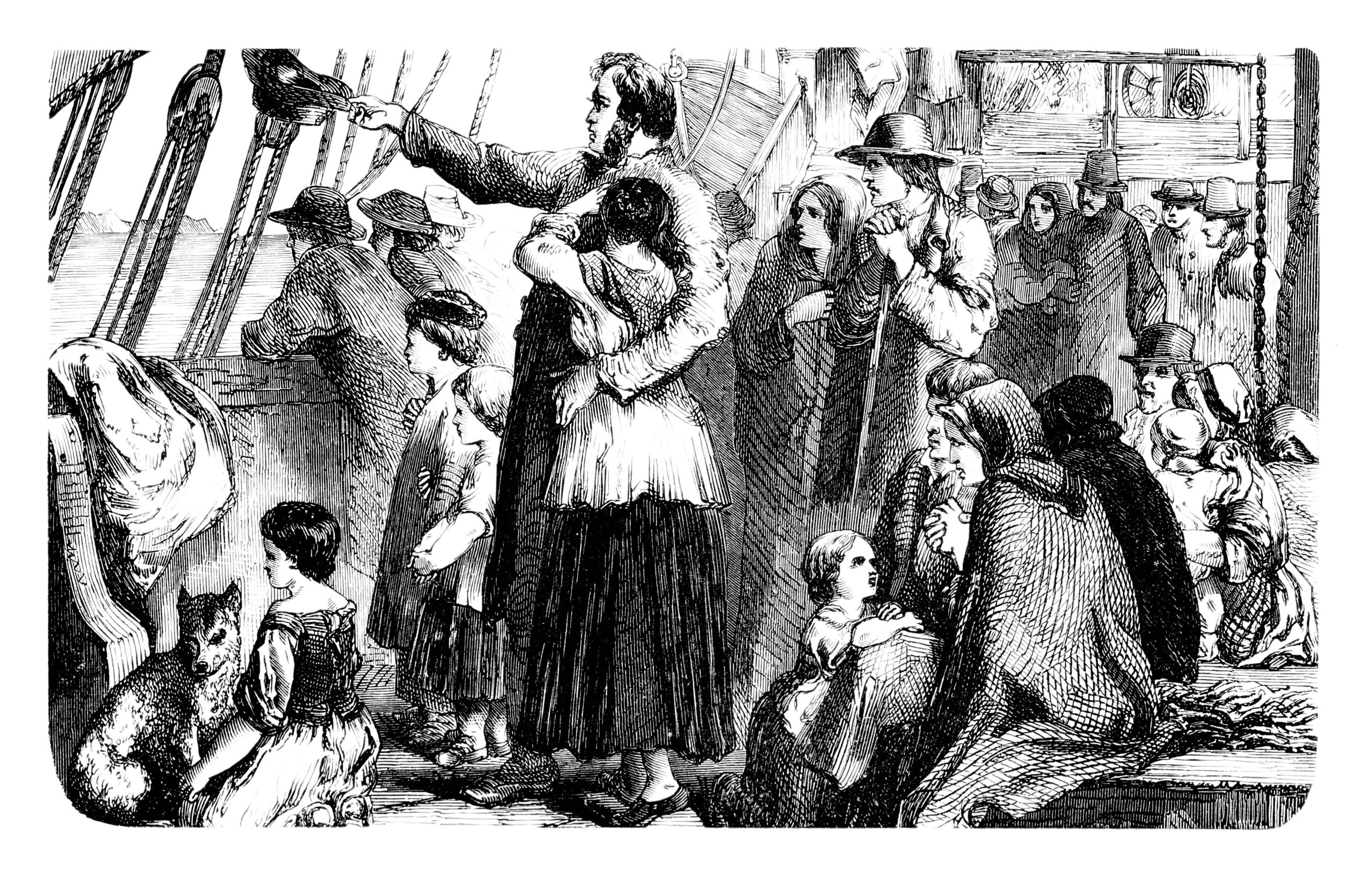10 Facts About the Irish Famine That Will Change How You See History

When we look back through the corridors of history to find events that have irrevocably shaped nations, the Irish Famine, spanning from 1845 to 1852, stands as a stark reminder of how tragedy can sculpt the fate of a country and ripple through generations.
Known in Irish as “A Gorta Mór” (The Great Hunger), this catastrophic period obliterated a significant portion of Ireland’s population through starvation, disease, and emigration. However, the depth of its impact goes beyond numbers and statistics—it dramatically altered the course of Irish history, culture, and identity, while influencing global immigration patterns and international relations.
Understanding the Irish Famine is crucial not merely for historical accuracy but for grasping the complex interplay of political decisions, economic policies, and social structures that can lead to such disasters.
This exploration of 10 pivotal facts about the Irish Famine aims to provide a comprehensive insight into its causes, consequences, and, most importantly, its enduring legacy. In doing so, we not only remember a tragic chapter of the past but also reflect on its lessons that remain profoundly relevant in today’s world.
Fact 1: The Scale of the Tragedy
The scale of the tragedy wrought by the Irish Famine cannot be overstated, as it stands as one of the most devastating events in Irish history. The death toll alone is a grim testament to the severity of the situation, with estimates suggesting that approximately one million people perished due to starvation and disease related to the famine conditions.
This staggering loss of life was compounded by a mass migration phenomenon, as another million sought refuge from the dire conditions by emigrating, primarily to the United States, Canada, and Australia.
This exodus was driven by desperation and the hope of finding a better life, but it also led to a profound demographic shift, both in Ireland and in the countries that the Irish diaspora settled in.
The impact of this migration is still felt today, with large populations of Irish descent spread across the globe, marking the famine not just as a historical event but as a catalyst for global change.
Fact 2: The Cause Was Not Just a Potato Blight
While the Irish Famine is often attributed solely to the failure of the potato crop due to a blight (Phytophthora infestans), this explanation overlooks the complex web of economic and political factors that exacerbated the catastrophe.
The dependence on a single type of potato for sustenance was not just an agricultural oversight but was deeply rooted in the socioeconomic policies of the time. British parliamentary acts and landlord-tenant relations in Ireland created conditions in which the rural population, primarily tenant farmers, had no choice but to rely on this one crop for their livelihood.
The potato blight was indeed the spark, but the kindling was prepared by decades of oppressive economic policies including high rents, absentee landlordism, and exportation of other food products out of Ireland, even as famine ravaged the population.
This scenario highlights how policy decisions and economic structures can contribute to disaster vulnerability, underscoring the famine as not only an agricultural failure but a failure of governance and economic justice as well.
Fact 3: British Government’s Role
The role of the British government during the Irish Famine is a subject of significant historical scrutiny, marked by policies that severely exacerbated the famine’s severity.
The response, or lack thereof, from Britain’s ruling authorities to the unfolding crisis in Ireland reflected not only a failure of empathy but also a stark adherence to laissez-faire economic policies of the era.
Policies such as the Corn Laws, which imposed tariffs on imported grain and kept food prices high, significantly hindered the importation of essential food supplies into Ireland.
Furthermore, the decision to continue the exportation of agricultural products from Ireland to Britain during the famine starkly contrasts with the dire need for food on the island.
These actions, coupled with insufficient and often ineffective relief efforts, underscore the complicity of British governance in the worsening of the famine’s impacts.
The legacy of these policies contributes profoundly to the discourse on famine, emphasizing the tragedy not merely as a natural disaster but as one magnified by human decision-making at the highest levels of power.
Fact 4: The Famine’s Impact on Ireland’s Population
The profound impact of the Irish Famine on Ireland’s population is both immediate and enduring, marking a significant demographic shift that has shaped the country’s history and identity. With the loss of approximately one million lives to starvation and related diseases, and another million forced to emigrate in search of survival, the famine drastically reduced Ireland’s population.
This depopulation was not merely a temporary blip; its repercussions have echoed through the generations, fundamentally altering the nation’s demographic landscape. The mass exodus during the famine years seeded Irish communities across the globe, yet it also left a void in Ireland that would influence its economic, social, and cultural development for decades to come.
The population of Ireland, particularly in the rural areas most affected, struggled to recover, and by some measures, the population did not return to pre-famine levels until the late 20th century. This dramatic population decrease and the long-term effects of the famine highlight the deep scars left on the nation’s psyche, underscoring the tragedy’s role in shaping modern Ireland.
Fact 5: Global Immigration Patterns Were Affected
concerning the Irish Famine underscores a monumental shift in global immigration patterns, primarily fueled by the desperate exodus from Ireland to destinations such as America, Australia, and beyond.
This resulted in what we now recognize as the Irish diaspora, communities of Irish descent scattered far and wide, leaving indelible marks on the cultural landscapes of their new homes. In America, cities like Boston and New York were transformed by the influx of Irish immigrants, who brought with them their traditions, beliefs, and sheer determination to succeed against the odds.
Similarly, Australia’s cities and rural regions felt the influence of Irish settlers, contributing to the diversity of its population and the richness of its culture. This global dispersal was not merely a migration; it was a transplantation of Irish identity, weaving a tapestry of interconnected stories across continents.
The legacy of the Irish Famine thus transcends its immediate tragedy, shaping the demographics and societies of nations worldwide in profound and lasting ways.
Fact 6: The Rise of Nationalism
The catastrophic events of the Irish Famine played a pivotal role in fueling nationalistic fervor and the quest for independence from British rule. Fact 6 in our exploration of this dark chapter reveals how the suffering and injustice experienced during the famine became a crucible for Irish nationalism.
The perceived inaction and oppressive policies of the British government during this period not only exacerbated the suffering experienced by the Irish people but also ignited a collective awakening to the political and economic subjugation they endured under British dominion.
This awakening sowed the seeds of resistance and a drive for self-determination that would manifest in the following decades. The famine, therefore, was not just a tragedy; it became a rallying cry for those advocating for Ireland’s independence.
It underscored the need for a governance that would prioritize the welfare of the Irish populace above all else, leading to an intensification of efforts to reclaim control over Irish land and governance.
The legacy of the famine, therefore, is deeply intertwined with the rise of Irish nationalism, marking a decisive turn in the long and tumultuous path toward Ireland’s eventual independence.
Fact 7: Literary and Artistic Responses
in our exploration of the Irish Famine illuminates the profound sway this historical event holds over the realm of art and literature, serving as a testament to the indelible imprint left on Ireland’s cultural consciousness.
The famine has been depicted through a variety of artistic lenses, manifesting in the somber tones of paintings, the poignant verses of poetry, and the compelling narratives of literature. Artists and writers have endeavored to encapsulate the anguish, despair, and resilience of the Irish people during this harrowing period, offering a visceral connection to the hardship endured.
Paintings like those by Daniel MacDonald and James Brenan offer haunting visual narrations of the famine’s impact, while the work of authors such as John O’Connor and Cecil Woodham-Smith provide detailed literary explorations of its causes, effects, and the human stories entwined within.
These artistic responses not only serve as vehicles of remembrance but also as powerful tools of education, ensuring that the lessons gleaned from the famine continue to resonate through generations.
The richness and diversity of these responses underscore the complexity of interpreting historical trauma, illustrating how art and literature can transcend time to connect us with the past in a deeply meaningful way.
Fact 8: The Famine in Irish Memory and Education
in our exploration dives into “The Famine in Irish Memory and Education,” unveiling the deep layers of its lasting legacy in the collective memory of Ireland and its diaspora.
The Great Famine, often referred to as An Gorta Mór in Irish, occupies a sacred place in the national consciousness, symbolizing a pivotal moment of suffering, resilience, and transformation. Its significance is underscored within the educational system, where it is meticulously taught as a central chapter of Irish history.
From primary schools to universities, students are introduced to the multifaceted dimensions of the famine, encompassing its causes, devastating impacts, and the profound social, economic, and political aftermath.
Through textbooks, historical documents, and engaging educational programs, the narrative of the famine is woven into the fabric of Irish identity, ensuring that future generations comprehend its magnitude.
This educational commitment ensures that the memory of the famine, along with the lessons it imparts about injustice, hardship, and the resilience of the human spirit, is preserved and passed on, affirming its indispensable role in shaping the narrative of the Irish nation and its people.
Fact 9: Scientific Contributions
in our exploration examines the significant influence of the Irish Famine on modern agricultural and disease research. The devastation brought about by the famine, particularly through the failure of potato crops due to blight, has had a lasting impact on scientific studies aimed at enhancing food security and combating plant diseases.
This tragic event catalyzed advancements in agricultural science, leading to a deeper understanding of crop diseases and the development of resistant crop varieties. Researchers have drawn lessons from the famine to innovate in the fields of plant pathology and genetics, working tirelessly to ensure that such a calamity does not reoccur.
Additionally, the famine’s role in highlighting the relationship between poverty, disease, and malnutrition has informed public health strategies to tackle these issues comprehensively. Thus, the Irish Famine’s legacy extends beyond its historical significance, influencing contemporary efforts to create a more secure and healthy future for global populations.
Fact 10: Ongoing Relevance
in our exploration emphasizes the ongoing relevance of the Irish Famine, drawing a direct line from the lessons learned then to their applicability to current global issues. The famine serves as a harsh reminder of the vulnerabilities interconnected with agriculture, the economy, and societal structures.
In today’s world, where climate change threatens food security across the globe, the echoes of the Irish Famine resonate with potent relevance. It underscores the imperative for sustainable agricultural practices, robust disaster preparedness, and responsive social support systems to safeguard against similar tragedies.
This historical episode also highlights the critical importance of political will and international cooperation in addressing not only the symptoms but also the root causes of famine, such as poverty, inequality, and environmental degradation.
By reflecting on the Irish Famine, we are reminded of the collective responsibility to learn from the past to forge a future where no population must endure the catastrophic consequences of such a preventable disaster.
Conclusion
Reflecting on the “10 Facts About the Irish Famine That Will Change How You See History” brings us to a profound understanding of why it’s paramount to remember such historical events.
The Great Famine, beyond its immediate human cost, fundamentally transformed Ireland, its population dynamics, and its place in the world. It’s a reminder of the dire consequences of political inaction, economic exploitation, and environmental disaster.
This tragic period in Irish history teaches us lessons about resilience in the face of unimaginable hardship, the importance of political accountability, and the power of community in overcoming adversity.
By remembering the Irish Famine, we honor the memory of those who suffered and perished, but we also equip ourselves with the knowledge to prevent history from repeating its darker chapters.
The legacy of the Irish Famine transcends the boundaries of Ireland; it’s a global story of human survival, resilience, and the indomitable spirit of a nation. In grappling with its historical lessons, we gain not only insight into the past but also guidance for confronting contemporary challenges with empathy and foresight.




